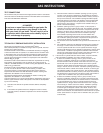
7
TYPICAL 20 LP PROPANE GAS SUPPLY INSTALLATION
We strongly recommend that you use the Summit
®
Built-In
Tank Cabinet (#21280) for installations using a 20 lb LP cylinder, mounted
remotely in an “island” structure.
The Summit
®
Built-In Tank Cabinet is a CSA listed accessory for installing
a remote mounted 20 lb LP cylinder, in an “island” structure. Summit
®
Built-
In Tank Cabinet has a hose and regulator assembly and gas connections,
for connecting a remote mounted LP cylinder to the Summit
®
Built-In gas
grill. The hose and regulator is listed as a required part of the CSA listed
Summit
®
Built-In gas grill.
The Summit
®
Built-In Tank Cabinet also meets the requirements for venting,
tank retention and separation of the LP cylinder from a heat source as
outlined in the ANSI Standard for Outdoor Cooking Gas Appliances, Z21.58/
CSA 1.6 for LP enclosures.
The Summit
®
Built-In Tank Cabinet has its own installation guide.
If you do not use the Summit
®
Built-In Tank Cabinet, you need to hire
a licensed contractor or licensed plumber and they need to follow the
requirements described in the ANSI Standard for Outdoor Cooking Gas
Appliances, Z21.58/CSA 1.6 for LP enclosures.
The requirements described in the Standard for Outdoor Cooking Gas
Appliances, Z21.58/CSA 1.6. are as follows;
A remote enclosure for an LP gas cylinder shall be ventilated by openings at
both the upper and lower levels of the cylinder. This shall be accomplished
by one of the following:
a). One side of the remote LP cylinder enclosure shall be completely
open; or
b). If the remote LP cylinder enclosure is designed to have four sides,
a top and a bottom, ventilation is required for the remote LP cylinder
enclosure;
1). There should be at least two ventilation openings, (a hole or group
of holes, for the purpose of ventilation) in the sidewalls of the island
structure. The openings should be located within 5 inches (127mm) of
the top of the enclosure. The ventilation openings should be equally
sized and spaced at a minimum of 90 degrees, and be unobstructed.
The openings shall have a total free open area of not less than 20
square inches. (This relates to 1 square inch of ventilation area, per
pound of stored fuel capacity).
2). Ventilation openings (a hole or group of holes, for the purpose of
ventilation) should be provided at fl oor level. The ventilation openings
should have a total free area of not less than 10 square inches. (This
relates to 1/2 square inch of ventilation area, per pound of stored
fuel capacity). There should be at least two ventilation openings
if the ventilation openings at fl oor level are in the sidewall. The
ventilation openings should be within 5 inches (127mm) of the fl oor.
The ventilation openings should be of equal size and be spaced at a
minimum of 90 degrees, and should be unobstructed.
3). The minimum size of the ventilation hole (s) should not be less than 1/4
inch.
4). The ventilation openings in the sidewalls should not allow venting into
the empty or “hollow” area of the “island”. If a gas leak should occur
or the LP cylinder should vent in the LP cylinder enclosure, the gas
should not be allowed to vent or migrate into the empty or “hollow” area
of the “island”. Ventilation openings in the sidewalls of the enclosure
should only communicate with the outside of the “island” structure, so
that the gas can dissipate outside of the “island” structure.
c). If the remote LP cylinder enclosure has four sides, a top and a bottom,
and is intended for installation in a built-in “island” enclosure;
1). At least one ventilation opening (a hole or group of holes, for the
purpose of ventilation) needs to be on one side of the enclosure
that communicates with the outside of the “island” structure. If a gas
leak should occur or the LP cylinder should vent in the LP cylinder
enclosure, the gas should not be allowed to vent or migrate into the
empty or “hollow” area of the “island”. Ventilation openings should only
communicate with the outside of the “island” structure, so that the gas
can dissipate outside of the “island” structure. The ventilation opening
should be located within 5 inches (127mm) of the top of the enclosure,
and should have a total free area of 20 square inches. (This relates to
1 square inch of ventilation area, per pound of stored fuel).
2). At least one ventilation opening (a hole or group of holes, for the
purpose of ventilation) needs to be on one side of the enclosure that
communicates with the outside of the “island” structure, at the bottom.
If a gas leak should occur or the LP cylinder should vent in the LP
cylinder enclosure, the gas should not be allowed to vent or migrate
into the empty or “hollow” area of the “island”. Ventilation openings
should only communicate with the outside of the “island” structure,
so that the gas can dissipate outside of the “island” structure. The
ventilation opening should be located within 5 inches (127mm) of the
bottom of the enclosure, and should have a total free area of 10 square
inches. (This relates to 1/4 square inch of ventilation area, per pound
of stored fuel).
GAS INSTRUCTIONS
TEST CONNECTIONS
All connections and joints must be thoroughly tested for leaks in accordance
with local codes and all listed procedures in the latest edition of the National
Fuel Gas Code ANSI Z223.1/NFPA 54.
ƽ DANGER
Do not use an open fl ame to check for gas leaks. Be
sure there are no sparks or open fl ames in the area
while you check for gas leaks. This will result in a fi re
or explosion which can cause serious bodily injury or
death, and damage to property.


















